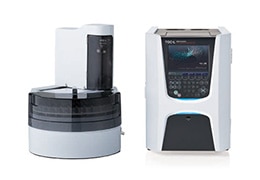
TOC-L Series

INDUSTRY
Life Science, Small Molecule Pharmaceutical
KEYWORD
INTRODUCTION SERVICE&PRODUCTS
TOC-L Series, ASI-L, SSM- 5000A, TOC-VWP, TOC-4200
Total organic carbon (TOC) analysis is increasingly being applied in the drug manufacturing process. The Japanese Pharmacopoeia Sixteenth Edition expands the scope of TOC to pharmaceutical water and TOC measurements are commonly used for cleaning validation. We asked Mr. Akiyama of Chugai Pharmaceutical Co., Ltd. about his opinions and requirements regarding TOC analyzers. His company uses Shimadzu TOC analyzers for cleaning validation for the manufacturing control of bio-related drugs.

Tomohiro Akiyama
API Process Development Dept.(Bio Technology)
Pharmaceutical Technology Div.
*Affiliates and titles of the interviewee are current as of the time of reporting.
Chugai Pharmaceutical co., Ltd.
URL
http://www.chugai-pharm.co.jp/hc/ss/english/index.html
Please tell me what you use the Shimadzu TOC-V for.
We use it for cleaning validation to guarantee that the equipment used for the manufacturing control of bio-related active pharmaceutical ingredients has been adequately cleaned and will not contaminate the next manufactured batch. Another department uses the same TOC analyzer for the management of pharmaceutical water.
Can you explain the sampling methods you use?

We perform measurements on two types of samples: rinse solutions and swabbed samples taken after the equipment has been cleaned. Where possible we use the swab sampling method because it allows more direct evaluation of residues on equipment. However, we have to use the rinse sampling method when the swab sampling method is not applicable, such as inside pipes. The sampling method is selected according to the part of the equipment, but both methods are used in most cases. Our department develops manufacturing methods and produces investigational new drugs. As we switch products more frequently than in a plant, it is even more important to check for residues. The analysis methods established here have been transferred to the Utsunomiya and Ukima plants.
Why did you select a Shimadzu TOC analyzer?
The major reason is the solid sample combustion unit that allows swab and direct-combustion carbon measurements. We wanted to use this method, which we believe offers advantages over the extraction method.
What is your major reason for using the solid sample combustion method?
When you have a swab sample, you can measure it by direct combustion or soak it in water to create an extract and analyze that. As it requires no extraction, the direct-combustion method eliminates extraction losses and increases the recovery rate. This method allows measurements with high sensitivity and high recovery rates. For these reasons, we use a solid sample combustion unit to measure the swab samples directly.
Other customers have asked about the risk of material from the swab remaining when a swab sample is taken. What is your opinion about that?
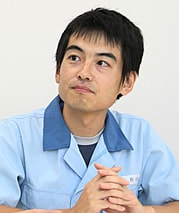
I think the risk is low, as the silica fiber filter paper used to swab the samples has low toxicity and the instrument is rinsed with distilled water after the samples are swabbed. In addition, the direct-combustion method is more versatile, as it recovers the entire sample from the silica filter paper.
Conversely, when the extraction method is used, the sample recovery rate is affected by the material used to swab the sample, and it may not be possible to extract sample that is adsorbed on the material. So, people using the extraction method must carefully investigate the swab material that they use.
I see. You seem to mostly use TOC for cleaning validation for bio-related active pharmaceutical ingredients. Have you ever tried any other methods, like using LC to measure small-molecule drugs, for example?
Yes, we mostly use TOC. When using HPLC for bio-related active pharmaceutical ingredients, proteins remaining on the equipment surface lead to a poor recovery rate when the samples are swabbed and extracted, and you have to investigate what method to use to detect the extracted samples. HPLC is not advantageous in terms of recovery rate or sensitivity and I think direct combustion of the swabs is better. What's more, the samples may become denatured and it is quite difficult to measure denatured proteins, so we like to measure proteins as carbon. In addition, TOC can detect buffer and other mediums in addition to proteins, allowing it to cover a wide range of contamination.
What are your honest opinions and impressions about using Shimadzu TOC?

Changing from the TOC-5000 to the TOC-V increased the number of samples that can be loaded in the autosampler. That has considerably increased the number of samples we can process in a day. Automatic acid addition and automatic dilution and measurement when the concentration is out-of-range make it considerably more convenient. Automatic shutdown and restarting are also surprisingly useful. As the TOC analyzer can't be used until the combustion furnace reaches temperature, it takes some time for the instrument to start up. Reducing this time would improve our work efficiency.
Another benefit is the low noise. As cleaning validation has to confirm that there is no contamination, significant noise may result in irregular measured values. I get the impression that the TOC-V tends not to pick up noise and offers very stable measurements.
Thank you. I think that the sensitivity of the TOC-V detector becomes higher than previous models and the noise level is lower.
I have a request. The solid sample combustion unit is a product with great merits. But the samples have to be loaded manually, and after loading a sample we have to wait for two or five minutes. Then, when the measurement is complete, the loaded sample has to be pulled forward a bit and allowed to cool down. During this process, the operator has to stay near the instrument, resulting in a lot of waiting time. I think there is room for improvement here. Could it be automated, for example?
Currently no autosampler is available for the solid sample combustion unit. How many samples are you thinking about?
It would be nice to be able to load 20 or 30 samples. Swab samples are not taken from just a single position in a tank, rather from a number of representative positions. So, multiple samples must be measured for each piece of equipment and a capacity of about 20 samples is required as we use more than one piece of equipment. I need to load many samples for the water tests for the rinse sampling method but I don't need so many samples when I use the swab sampling method for cleaning validation.
I'd also like a function that automatically creates calibration curves by automatically combusting and measuring a disposable standard-sample kit that is loaded in the unit. Such automation would probably increase demand for the unit.
So, the market would grow and the range of choices would expand. This is a little ambitious for the product and we would have to come up with ingenious solutions to do it. We will use your comments as a reference for future development work.
A request I have for the current instrument is to make it clearer when measurement of a swab is complete. At the moment, only a message on the computer screen indicates that the measurement has finished. It would be useful to have something like a buzzer that announces when the measurement is finished, even if the operator is sitting in front of the solid sample combustion unit.
With the computer arranged at the left, the TOC analyzer in the middle and the solid sample combustion unit, you have to move around, don't you?
It takes a long time for the solid sample combustion unit to heat up to temperature, so we have to hang around for quite a while after setting it up. I would like the unit to heat up as fast as possible.
I will take your ideas back with me and we will refer to them for future product development.

If the same TOC analyzer is used in a number of different locations, the measurement results may be affected by the installation environment. I would like you to develop instruments that are as unaffected as possible by the ambient environment. When the technology is transferred somewhere else, this would allow us to install the same instrument and use the same protocols to acquire measurement values with the same quantitation limits.
We only have information from a few instruments. I would like to be able to get information on the discrepancies occurring due to actual installation environments, so I could know how much change in the environmental conditions is acceptable.
For example, I sometimes worry if it is OK to use organic solvents in the liquid chromatograph in the next room. Of course the solvents have some effect, but it would be easier to make the call if I had information on the degree of this effect.
This is quantitatively difficult but maybe we could provide more information in the pre-installation requirements. It is easy to indicate the degree of temperature gradient but more difficult to show the effects of organic solvent atmospheres. So, for example, material indicating what effects occur in a certain atmosphere would be a useful reference, wouldn't it?
Have you had any actual cases where you have suspected effects from an organic solvent atmosphere?
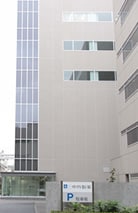
Not yet, but I worry the effect for the measurement values. If it occurs, I need to stop measurements. I am not able to be responsible for them. So, I would like some data to tell me what was deemed acceptable before. The biggest problem I have is wondering whether I am worrying too much. I'd feel more comfortable if I knew whether I need to be concerned or whether the results are all right.
As this is an important issue for you, we will investigate the best way to supply the information and put a system in place as soon as possible.
Do you have any comments about maintenance?
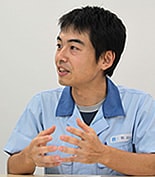
When a problem occurs, I can phone the engineer who comes round to inspect the instrument and get some accurate advice, which I find really helpful. Also, some manufacturers tell the user not to perform maintenance or replace parts. However, Shimadzu encourages the user to perform simple maintenance and even organizes training workshops, which I find really useful. I would therefore like to see instruments that can be a little more easily maintained by the user.
I sometimes see instruments with a maintenance guide presented as a series of photographic prompt cards. If the system displays the guide in the maintenance help on the data processing screen, the result can be a little better when the operator follows the instructions on the screen. So, before making any hardware changes, maybe such a guide would make a difference. What do you think?
You are right. I think the photographic prompt card method would be good. When the description is in words, if they mention a "drain tube" for example, sometimes I don't know which tube is the drain tube. Even if I ask by telephone which one it is – "the one at the back?," " the one at the front?," " the white one?," "the fat one?" – I get some idea and I do what they say. But it would be safer and more accurate if I could see images.
Do you think the manual is a bit hard to understand when you are doing this type of maintenance?
Yes, it can be. The manual has diagrams but photographs would be easier to understand.
At the very least, more diagrams and photographs would make it easier to understand, you mean? It's a little off subject, but we have formed a CS Management Department within the Shimadzu organization to produce and check the manuals for the entire company. I think that will gradually improve the quality of the manuals and eventually better maintenance guides will become available in the future.
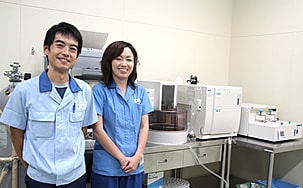
I look forward to that.
You perform annual inspections as OQ inspections, don't you? If service plans were available, what sort of plan would you like to use? At the moment, we perform your annual inspections. We also offer a TOC maintenance agreement. Would that interest you?
I think that it is good to have a maintenance agreement in the event of a failure in a situation where many TOC analyzers are in use, like in a plant. In a department involved with investigational new drugs, like mine, the instrument is used to ensure the critical cleaning validation. Therefore, maintenance of the instrument is very important.
I see. Please give it some consideration. Currently, TOC is mainly used in the pharmaceutical field for pharmaceutical water management and cleaning validation. However, in the future, TOC may be used in all stages of drug manufacture. Do you have any particular thoughts about this?
On-line measurements are becoming more important, I think. There are trends around the world to install TOC on-line analyzers in addition to the on-line water management used previously. So, I think it is now important to perform on-line cleaning validation as well as water management. I think we will have more and more opportunities to apply the keyword "on-line" to TOC analyzers in the future. Cleaning validation is a sort of behind-the-scenes check operation, akin to cleaning up after cooking. It is extremely important. It is critical to confirm the adequate cleaning of equipment used to manufacture investigational new drugs that are administered to people. Not many instruments are available for such validations and the TOC analyzer is one that plays a major role. Shimadzu TOC analyzers are the core instruments that we use for cleaning validation and they are extremely useful.
Your comments today have been very useful. Thank you very much.
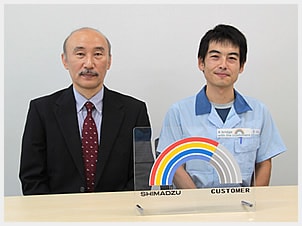
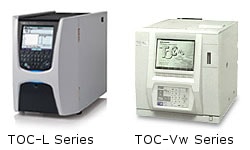
The direct-combustion carbon measurements using swab sampling, used by Chugai Pharmaceutical Co., Ltd. for cleaning validation, is a technique that was proposed by Shimadzu over ten years ago. However, I discovered recently that it is being effectively used for manufacturing control. The comments I heard today re-confirmed the utility of this method for cleaning validation. On the other hand, I heard suggestions about the automation of measurements. This has renewed my conviction that we must incorporate such suggestions and requests from customers to develop easier-to-use instruments and systems.
* "TOC-L" is the current model of combustion catalytic oxidation method analyzer.